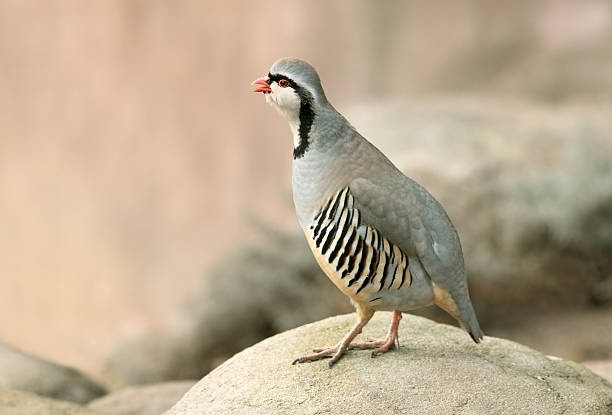
Won’t You Be My Neighbor? The author has encountered a pair of chukars on a few walks and heard them calling in the hills around his home. The birds are native to Mediterranean Europe and Asia and often used for dog training, feral and introduced populations have established themselves throughout the U.S. Photo: Creative Commons Unlimited Usage Allowed.
By Nick Simonson
I first saw our new neighbors in the dim light of an early February morning. As I walked the dogs past their driveway, they cautiously eyed us over but, unlike the residents who had been on our block for a while, they didn’t take off when both my large lab and German shepherd made sudden furtive movements toward them. I found that odd. The next encounter was much the same. Though this time, one of them was up on the rooftop of the house across the street surveilling their new neighborhood, again just before sunrise. He let out an unfamiliar and startling laugh as we approached and paused to offer our own greeting, but he didn’t depart despite the lunging dogs once again trying to make friends.
Finally, while working out in my basement just last week, I happened to glance out the window to the small strip of side yard and noticed both of the new arrivals to our development wandering through the small shoots of green grass a piles of dog poop left over from the long winter. It was then that it all came together.
The reason these two oddball immigrants to our neck of the prairie didn’t take off like the flighty covey of Hungarian partridge that have lived in the gully-fringed stretches of our piece of suburbia was that they weren’t partridge at all, but rather, they were chukars. With a funny obliviousness, they made their way through the yard, hopped up on the fence and down into the next-door-neighbor’s yard and disappeared from sight. It was likely that they were escapees from a hunting dog test, as chukar are often used by hunters to train new dogs, or to keep older ones sharp in the off season. Planted and placed in the grasses of those hills just a half a block away, they had likely avoided detection in one such training session and unlike some of the less-fortunate birds in their covey, were spared the teeth of an aggressive pup looking to prove its mettle.
I texted the sighting to a friend at Game and Fish, and he confirmed not only that a good population of the volunteer upland birds existed around town, likely coming from that hunter-based source, but that there were enough of them in the area to sustain a breeding population as well. Amazed by the development, I’ve kept a sharp eye and ear out this spring, listening for the chuk-chuk-chuk call mixed in with the day’s score of robins chirping, mourning doves cooing, and the dawn-and-dusk call of rooster pheasants clanking through the hillsides of our two-block area. Sure enough, while cleaning the yard, walking the dogs, or relaxing on the deck in the limited spring we’ve had, the chukars are out there too, seemingly enjoying their new digs.
While they more often succumb to the weather and predators seizing on the birds’ naivete from being raised on a farm or in a pen for the purpose of dog training, it appears some chukars have better survival skills than others. I note that despite not being the most wary introductions, they often assume elevated positions, which likely keeps them out of harm’s way from those random neighborhood dogs, and even the den of coyotes just down the draw which still howl in the shrinking darkness of early morning. Whether perched on a rooftop at sunrise, or randomly offering up their cadence of chuks as the mornings warm, they’ve quickly become a notable and enjoyable part of all those things that mix where the edge of suburbia meets the first fringes…of our outdoors.
